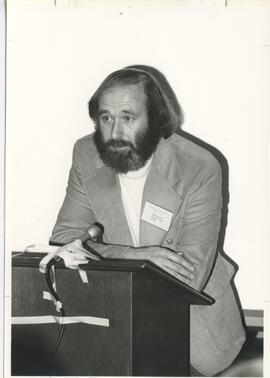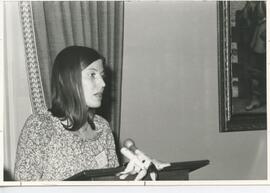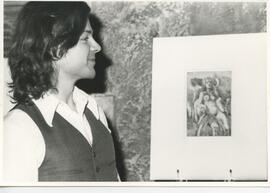This item contains an interview conducted with Mr. and Mrs. Sommer. Mrs. and Mr. Sommer are talking about the farm life and their lack of money until the end of the 1930s. They bought their farm taking out a loan with the help of his brother and it paid back step by step. It was a difficult time for them. Their children learned English quickly at school, but Mrs. Sommer mentions that she did
not have any lessons, and could only learn English by herself which took some time. Children went to a German school. Later the children and grandchildren were able to speak English better than German. Mr. and Mrs. Sommer say that they did not had any problems during their journey to Canada because of being Germans.
Mr. and Mrs. Sommer talk about going to church (Lutheran Church, later Protestant). Sermon was preached by a teacher because the German pastor came only once in six weeks.
They came to Edmonton in 1957. Mrs Sommer compares life in Russia with their life in Canada and says that they needed about five years to feel at home in Canada. Later they learned to enjoy their freedom and didn’t want to get back again. They became
Canadian after a few years living in Canada.
Mrs. Sommer talks about speaking German and learning English language. German remained her main language. Mrs. Sommer says that she still cooks the way she learned it in Russia (sauerkraut and borscht).
Mr. Sommer has one sister living in Germany and they have many grandchildren living in Canada.
This item is a recording of an interview with Mr. and Mrs. Fenske, recorded February 13, 1982. Mrs. Fenske discusses how a whole community came to Canada by boat because of the Depression and were pressed to join the Orthodox Russian Church, but did not want to. The church was the centre of all activities with service three times per day. They used the German language at home, and their parents went to German school back in Russia. Mr. Fenske's father came to Canada alone in 1893, Mr. Fenske was born in 1902.
Fenske, Mr.This item contains an interview with Mr. Eichele and Mr. Louis Oel, conducted in Calgary, AB in German on August 25, 1982. Content of the interview contains discussion on their school years – walking about 3 km to the school. The important role of the priest and church – every morning had to go first to the church. On weekends, visited the church twice or even thrice, The Albert Cattle Association, paying big taxes while being unemployed, and taking over an agency in Calgary
Eichele, Mr.This item contains two interviews, one conducted with Mr. and Mrs. German, and another with Mr. Eichele. M. German was born in 1909 in Odesa, although originally the family came from Germany and spoke German. His parents were farmers. They came on a steam boat from Liverpool to Halifax, they then came to Regina on a train from Halifax where he had an uncle, and moved to Alberta in the Spring of 1910, to Bow Island, an area with many Germans. His dad built a house, which was more like a shack, where they had some animals. His dad grew wheat. He took over his dad’s farm. During WWI, when they already lived in Canada, his family did not have problems because they were Germans, although they did experience tough times during the Depression. Mr. and Mrs. German got married in 1924, then bought the land. In 1940, they came to Calgary. Then sold it and bought the lot and built the place they were being interviewed. Retired in 1968. Have 2 children. Mrs. German's parents came from Russia, too ([Menheim] near Odesa). She was born in the USA, in Mackintosh, North Dakota in 1907. Her parents had a homestead over there. Then they moved into Alberta in about 1908. Her father got a homestead in Alberta. They moved together with a big German community. She had 6 siblings and was the youngest, 2 from the previous marriage of her dad. Her family was Catholic and spoke German.
German, John LennardThis item is a recording of a meeting held of April 10, 1976, where the constitution of CEESSA was read and discussed.
This item is a recording of a meeting of CEESSA. Discussions include the question of Hungarian and other courses at the university, the constitution and procedures of the committee, membership dues, and the name of the society.
Department of Education set up a committee on curriculum development but will there be ethnic content or just Canadian? “Units” of studies: “Ethnic mosaic” and “Alberta”. Making sure the ethnic groups get recognition in the history of Western Canada. Working together with Heritage Council History of Western Canada discriminates certain ethnic groups. Some Social Studies programs need to be revised.
Important feature – sizable new groups of immigrants from Eastern Europe. Travel concerns to those countries.
80% of Germans in Alberta are from Eastern Europe. Up to 40% of Alberta population is from Continental Europe
This item is a recording of an annual general meeting in [1976]. Reports were given by the President, Secretary, Treasurer, Academic Research Committee, Publicity Committee, and Executive Director. A new board was elected.
Continuation of Presentation by Mr. Petr Czarnowsky: Eastern Europeans, despite their proportion of the population, came to form a large number, often over 50% of ethnic associations in Alberta. This includes ethnic organizations, arts organizations, and linguistic schools. Policies of multiculturalism have helped to form these figures, but have had the unforeseen consequence of adding to confusion about Eastern European ethnic groups on the part of students and teachers alike.
Presentation by Mr. Joanna Mateko on the problems already being faced in the study of Poles. She came from Poland associated with the Polish Academy of Sciences in Warsaw for 15 years. She did work in the field of Polish history, having published numerous articles and co-author of bibliographies that were compiled by the Polish academy of sciences. She does her research on the Poles in Alberta. A problem that exists in the study of Poles is the inaccuracy of academic and official documents pertaining to Polish settlement in Canada, and the difficulty in unearthing accurate depictions and statistics of Polish settlers, and Slavic settlers more generally. This can be derived from a lack of knowledge from Canadian officials, and a lack of consciousness amongst many Slavic groups, particularly the Poles and Ukrainians.
Presentation by Mr. John Sokolowski, a graduate student in the department of Slavic Languages, his first graduate program was as a Classicist. He does work on the Russians and Belarussians. He started his work on the East Slavs, the Russians, Belarussians, and Ukrainians in Alberta. They no longer work on the Ukrainians as so much work has been published. They started their study with the Russians and Belarussians, they hope to determine an accurate number of people of Russian and Belarussian origin in Alberta. Contention on the accurate number of Russians and Belarussians in Canada, as the definition of Russian has changed over time, with many early documents associating many non-Russian ethnic groups as Russian. Dynamics have changed with census records over the years, which still continue to be unreliable. There is thought to be far more Belarussians in Canada than official census documents would suggest.
Presentation by Mrs. Dr. Yermilla Horna University of Calgary Department of Sociology. Dr. Horna was educated in Prague and Bratislava came to Canada in ’58, taking part in the project doing the history of the Czechs and the Slovaks. She got a grant for the study of patterns of adjustment of Czechoslovaks, the so called refugees of 1968-1969. The study focused on pre-1968 settlement of Czechoslovaks in Canada to figure out if incoming refugees had a previous basis to go off of, or had to ‘start from scratch’. Research found majority of Czechoslovaks came to Alberta as miners, farmers, or other labourers, mostly from Slovakia. Greatest wave of Czechoslovak migration prior to 1968 came in 1885. The recording cuts out before she can say more.
Continuation of the speech made in tape c263-b: The community is served by the university in the same way as elementary schools but on a different level.
Mr. Birov: A foundation for Hungarian history would cost half a million. The government promised that if the foundation reached half of that ($250,000) the government would match the rest. Due to such a small Hungarian group, they had trouble reaching that. Is there anywhere else that could be approached to acquire the other quarter million? What do ethnic groups have to go through to get cooperation?
[The person with the recording equipment had to leave]
Opening speaker: Several objectives: 1. Have academics and community interact. 2. To have interaction among ethnocultural groups. 3. To reduce intergroup tensions. 4. To see what educational resources there are to accomplish the first 3 goals. What is the ambitious goal? To ensure we and our children know about each other. To remember that Canada itself is part of the global village.
Dr. Lock: Recites a poem.
Presentation by Dr. Yamila Horna, Chair of the Department for Soviet and East European Studies: This is a great opportunity to share one’s heritage the one brings to this country. This is one of the few opportunities where people from academia can share contributions to the community.
Dr. Golitsyn: Some anecdotes about his family. Always gets asked where he’s from, for some reason someone interested in Eastern European studies must be from Europe. Has Canadian roots though. Feels as a North American Canadian and an European Canadian too. The government will at some point have to look at our roots, our heritage. The British and French like to call themselves the founders, but the Celts a while ago had a conference, and they also had a large role. Even the French component if very Celtic. What about the other Europeans? That which divides us is far less than that which binds us together. Have been asked to look at the roots of this organization and its destiny. The destiny is great, it brings people together in the area of learning. Our schools DO teach us about us. Our schools MUST teach us about us. The interest of the academics is bringing people together to make these kinds of things happen. There are many people who are not necessarily Slavic or Eastern European that will be interested in Slavic and Eastern European studies. By this time next year there will be a patent as a society, and some legal status, and that we will be electing a national and regional board. Those from each province will be asked to meet together as one group and recommend who will be their two representatives to the national board, who will serve in the interim as provincial chairman.
Some closing remarks about a cathedral made of rocks.
This item is a recording about artist William Kurelek and author Myrna Kostash


